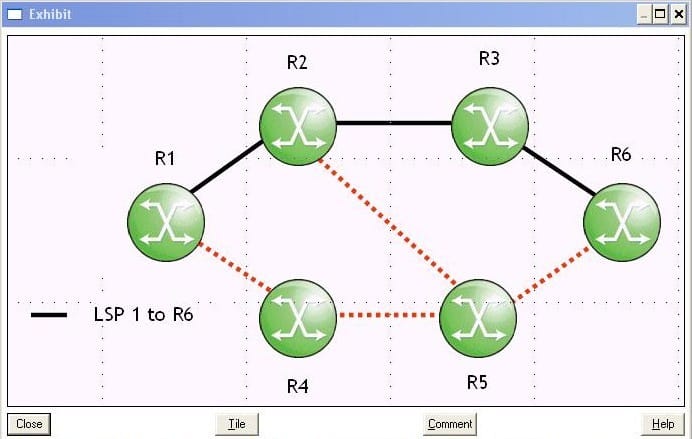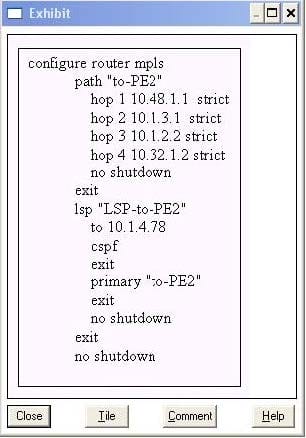Exam Details
Exam Code
:4A0-103Exam Name
:Nokia Multiprotocol Label SwitchingCertification
:Nokia CertificationsVendor
:NokiaTotal Questions
:249 Q&AsLast Updated
:Apr 13, 2025
Nokia Nokia Certifications 4A0-103 Questions & Answers
-
Question 151:
Fill in the blanks: The device at the beginning of an LSP is referred to as the_________, and the device at the end of an LSP is referred to as the ___________.
A. PE, P
B. LER, LSR
C. LSR, LER
D. iLER, eLER
E. eLER, iLER
F. P, PE
-
Question 152:
The destination IP address of a received unlabeled packet is successfully matched in the FIB. Which of the following is FALSE?
A. A POP label stack operation may be performed.
B. The outgoing interface and next-hop address will be determined from the FIB.
C. The packet can be forwarded as a labeled or unlabeled packet.
D. A PUSH label stack operation may be performed.
-
Question 153:
Which LSA is used for OSPF-TE purposes?
A. Type 9 LSA ?Link local LSA
B. Type 10 LSA ?Area local LSA
C. Type 8 LSA ?TE router LSA
D. Type 11 LSA ?Network LSA
-
Question 154:
How have Traffic Engineering extensions to IS-IS been implemented?
A. By defining new LSAs for the IS-IS protocol.
B. By utilizing the OSPF opaque LSAs to maintain interoperability with OSPF routing domains
C. By defining new TE extension TLVs to the IS-IS protocol.
D. By enabling CSPF algorithm extensions that allow link state TE to be implemented.
-
Question 155:
Which of the following statements regarding admin groups is FALSE?
A. Admin groups can be configured using the command "configure>router>mpls>admin-group".
B. CSPF uses the information defined by admin groups when paths are computed for constraint- based LSPs.
C. By default, interfaces for which MPLS has been enabled are in the default admin group.
D. A LSP can make use of admin groups for constraint-based path calculations by including or excluding the admin group
-
Question 156:
Which of the following devices can originate an opaque LSA?
A. TE enabled OSPF routers
B. Backbone router only
C. ABR only
D. ASBR only
-
Question 157:
Router R3 signals an LSP, reserving 1Gbps bandwidth on a 10Gbps link. RSVP configuration limits reservable bandwidth to 20 percent on the egress interface. Which of the following statements is true?
A. The egress RSVP interface has 80 percent bandwidth unreserved.
B. LSPs can reserve an additional 9.9 Gbps bandwidth on this RSVP interface.
C. The head end reserves 100Mbps for the LSP.
D. The egress RSVP interface has 1Gbps bandwidth unreserved.
-
Question 158:
Which of the following are features of RSVP-TE? Choose three answers.
A. It supports IGP-based LSPs.
B. It supports constrained path LSPs.
C. It does not support loose explicit path LSPs.
D. It is recommended for use in Traffic Engineering applications.
E. It cannot be used with facility backup fast reroute.
-
Question 159:
Click on the exhibit button below.

LSP 1's link between routers R3 and R6 has failed, and the RESV state at router R3 has timed out. Which of the following actions will router R3 initiate?
A. Send a Path Tear message towards router R6.
B. Send a Path Tear message towards router R1.
C. Send a Resv Tear message toward router R6.
D. Send a Resv Tear message toward router R1.
-
Question 160:
Click on the exhibit button below.

Given the configuration below, which of the following commands would enable fast reroute on the LSP? Choose two answers
A. This configuration already is configured for FRR.
B. fast-reroute facility
C. fast-reroute one-to-one
D. secondary
E. standby
Related Exams:
4A0-100
Nokia IP Networks and Services Fundamentals4A0-101
Nokia Interior Routing Protocols4A0-102
Nokia Border Gateway Protocol for Internet Routing4A0-103
Nokia Multiprotocol Label Switching4A0-104
Nokia Services Architecture4A0-105
Nokia Virtual Private LAN Services4A0-106
Nokia Virtual Private Routed Networks4A0-107
Nokia Quality of Service4A0-108
Nokia Multicast Protocols4A0-109
Alcatel-Lucent Triple Play Services
Tips on How to Prepare for the Exams
Nowadays, the certification exams become more and more important and required by more and more enterprises when applying for a job. But how to prepare for the exam effectively? How to prepare for the exam in a short time with less efforts? How to get a ideal result and how to find the most reliable resources? Here on Vcedump.com, you will find all the answers. Vcedump.com provide not only Nokia exam questions, answers and explanations but also complete assistance on your exam preparation and certification application. If you are confused on your 4A0-103 exam preparations and Nokia certification application, do not hesitate to visit our Vcedump.com to find your solutions here.